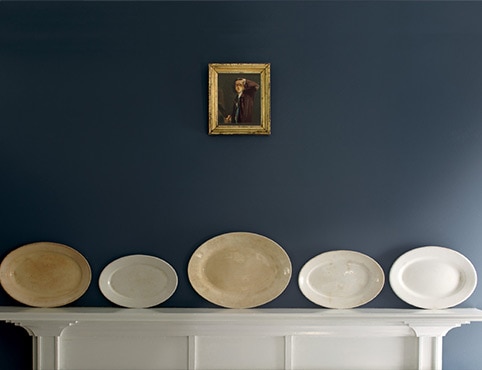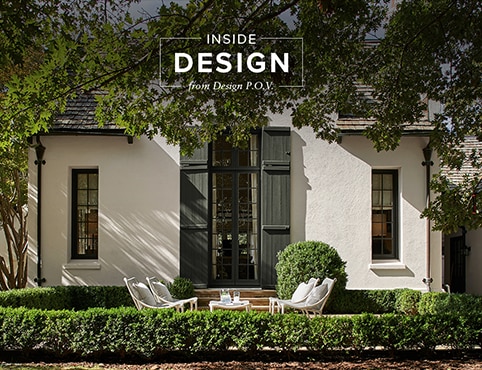Trendy vs. Timeless Design
Balancing Both, with Matthew Patrick SmythRead What Matthew Patrick Smyth Has to Say:
From his Connecticut home, New York-based interior designer Matthew Patrick Smyth shares his thinking on a key element of the design process–balancing the timely with timelessness.
“Balancing timely and timelessness is a process that we're always dealing with as designers. What's new? What's trendy? What's going to last? What's going to stay? What has staying power? It's something we always ask ourselves. People say ‘do you deal with trends?’ Trends come and go. And yes, I do. I'm aware of them. And sometimes a trend could be turned into a classic.”
“I remember in the late 80s, early 90s, everybody thought the trend was sisal carpets and sea grass, and that was going to come and go, and too many designers were using them. But that stayed, so sometimes these moments turn into a classic. But I'm always trying to figure out what has staying power. And, at the same time, balancing it with things that amuse people, that are of the moment, that make people feel good. And you don't want to get too wrapped up in worrying about what timelessness is because after a while it becomes innate as you're looking at things. And especially if you're looking at quality pieces, and things that are time-tested, and that will fall into place easily.”
“But I have clients who fall in love with things, and it seems like it's very trendy. And I encourage them to go for it because it gives them joy. But I think when you're already using something that may be a trend, you have to figure that it also comes with an expiration date. And if you're prepared to move on from there after a while, after that trend wears off, and it's not as attractive as it once was, then go for it.”
“I think people are asking more for tested and timely. Timeless designs, patterns and colors. But that doesn't mean it can't be balanced with something that's new and current. Sometimes one can play off the other, and sometimes they can work beautifully together. So it's a matter of balance. It's a matter of just being appropriate at the moment.”
“When I work on a room, I think I can see it five different ways. And that's our job, to have some flexibility in how we approach a design for a room,” says Smyth. “Often you get clues from your clients. And maybe it's not what they like. It's sometimes just getting information about what they don't like that leads you to the best solution for them. And that's sometimes based on things that they've seen in their life, in their travels, and their friends, and you play off that. And then you try to separate what might be just of the moment, and what might be classic. I always say you can incorporate both of them. If it's an investment piece, I try to make it a little bit more classic and more timeless because I don't want them to get bored with a really good piece. This could be a good antique or a very well-made new piece, made by a craftsman that will stand the test of time. Quality does that. Quality never fades out. It's rare that one can get bored with something of great quality. That just won't happen.”
Smyth shares that trends come and go, “but I think it's important to be aware of them and sometimes we have to incorporate them. Sometimes it comes with a project. As long as the client knows when it's time for the piece to go, when that trend has to leave the room and we bring something else new to take its place.”
Smyth worked on a beach house in the Hamptons where the client was only interested in that season’s trend. “She was prepared to let it evolve, and I think that's important with rooms. Rooms evolve. Just because you install them at one time, it doesn't mean it has to stay that way all the time. You can change things around, mix them up later, maybe put some things away and bring them back later.”
“I do that all the time. I'll walk around my house and think, ‘Okay. There are too many things creeping into my house. There are too many accessories. There are too many things I bought on impulse,’ and maybe put it away for a few months, maybe a year or two, and then bring it out again. This morning, I went to my closet. Something caught my eye and I brought it out again. A year ago I was bored with it. Now it looks new. Things can evolve. You're not locked into one room and one solution.”
“I don't buy anything just to fill a space. There has to be a reason why I was attracted to the piece in the first place, whether it was the texture, the silhouette, the quality of the piece, the design, something amused me, something triggered an emotion. That's why I bought it. But that doesn't mean that I won't get tired of it after a while. But if I bought it for a good reason and because it was an intelligent choice to buy it, I'll hold onto it because I know someday it'll come back, it will reunite with me, and I'll feel differently about it, and I'll find some renewed interest in it.”
Balance Trends and Timelessness as Your Interior Evolves
Smyth counsels to let your interiors evolve with you, like everything else in life. The way you look at something will change, your tastes evolve with travels, with life experience.
“I never want to lock myself into a certain period. Because there's always a unique piece that comes to me that I fall in love with, and it's from that period that I just denounced. So I don't try to do that because I'm always surprised that there would be a Victorian piece that I would really love. A house full of Victorian? I'm not sure I would go there. But what's nice about older pieces and antique pieces is that somebody took time and effort to design it and make it. And so there's a story behind each piece, with a good silhouette, good lines, good design and good proportions that will blend well in with other pieces.”
“You don't want to have a room full of all of the same period, but mixing it and balancing it with more contemporary pieces makes that piece special. It's almost like sculpture in a room. You could have a very fancy Rococo piece in a white room, and it just stands by itself. And the beauty of the piece is highlighted by the simple background. So I never say never because I'm always surprised. I always surprise myself. And that's part of the journey of being a designer, you get out there, you see things, you experience new places, and explore different corners and avenues that make you appreciate the history behind your profession.”
Smyth notes that he keeps coming back to one word: balance. “I think that is the core of what we do. It's about balancing trends. It's about balancing client needs mixed with what you love, what you think they should be looking at. It's about balancing lifestyles. Balance is the key word. It's about balancing pieces in a room, that one complements the other, balancing colors. Interior design is all a balancing game, it's the main part of the process. You have to take so many things into consideration as a designer. And how do you balance that out? How do you balance that so the final product's not chaotic, that there's a harmony between what you love and what the client loves, that you can come to an agreement on how the project will turn out.”
“We're constantly juggling with various aspects of technology versus aesthetic. And for me, that's the fun part of the job. I love this process, and thrive on it. It helps me narrow it down. If I can see a room in five different ways, I need something to help me corral my thoughts, and that’s the sense of putting the pieces together for somebody, and how they want to live, how you think they should live. Just finding a balance between the two is what makes great design. And it's putting all those elements together that separates a perfectly nice room from a great room.”
Smyth finds that often, clients come with their own art collections or art advisors. Then, there are clients a designer can help with finding pieces, which is fun. It's finishing the room, helping the client pull everything together. Creating happy memories for clients will always be timeless in a room because it's part of the joy of putting it all together. This is why they hire a designer.
Smyth believes that when it comes to interior design, “it's not about me. Clients come to me because they want my eye, but at the same time, they have to feel comfortable in the house. When I leave it, it has to look like them. A sense of a timeless room is if the person is in there, and feels comfortable and looks good in that room. It doesn't matter when it was done and who did it. It will stand the test of time.”
“It's our job to make sure that a client is comfortable after the fact, and it's not our personal statement, it’s their personality, their history, who they see themselves as, and who they want to see themselves as, who their family is, all plays into the role. That's what makes a great room.”
Smyth also touches upon keeping up a relationship with clients over many years. “Things change. People's lives change. I downsize for people all the time. I upsize for people. It's amazing that that happens a lot. At this stage I'm on my third generation of clients. I'm dealing with clients' grandchildren. I had an assistant who left the firm and then returned, and she noted that almost all the clients were the same as when she left to have her children.”
“I'm happy to be part of the change process. I've moved many people and what's nice is that you moved into someplace fresh, and you use their things that they've had before, and you mix them with some new things that are more appropriate, especially if you're moving a client, for example, from up north to Florida. A lot of pieces look great in the Northeast. But they might not look so great in the Florida light. So you change the pieces that you can, and the fabrics, and the window treatments, and the wall colors. And then you bring in the other furniture, and it feels like home. And they continue to relate to each piece. And even though it's very different, it’s still familiar for them. And that's nice. It's about making homes. That's what we do. We make homes.”
“For homes I'm working on now, it's small things like taking into consideration where they charge their iPhone at night. Everybody has a different level of comfort as far as technology goes. And some clients love everything maxed out on their iPhone and apps that they can control from a distance or within the house. Others just want an on and off switch. Everybody's different.”
“But as designers, we have to be aware of it all. Take just the changes in the lighting industry and bulbs, warm bulbs versus cool bulbs. People are buying the wrong light bulbs now. Everything is changing. We have to be on top of it. It's changing probably more now in the last five years than it has ever changed. And it'll keep changing. So it's important for designers to keep up with what's going on. But, at the same time, make it simple. It doesn't have to get over complicated, it’s only good if it makes their life easier.”
Smyth emphasizes that above all, “you still want to keep a human element to home. Home is very tactile, and you should be able to turn on a light switch, it's not just the process of getting a light in the room, but it is about the ritual. Coming into a room, turning a light on, getting that immediate sense of what the room looks like when it's lighted again. You don't necessarily have to do that from an app from your car before you arrive home. There is part of the process of living and just normal rites of passage into spaces that it doesn't have to be controlled by an app.
“One of the reasons I wrote my new book, Through a Designer’s Eye, was that my last book was about ten years ago, and I wanted to do a book about lives that were changing, including my own. I went from a circa 1790 house to a 1970 house, and from a town to the woods. My life changed and I wanted something new.”
“So my book is about change. And I think that's the key thing that emerges in each chapter–change. Changes in life, and clients' lives, evolving, I think we're in a period of change and design changes, but also remarkably it stays the same. With the new book, I wanted to show the balance between the two.”

Historical Collection
The Historical Collection offers 191 hues inspired by 18th and 19th century American architecture.

Matthew Patrick Smyth Inc.
"When I narrow down how a space should develop, it starts with color."

Inside Design
Explore distinct design topics from the interior designers featured on this page.